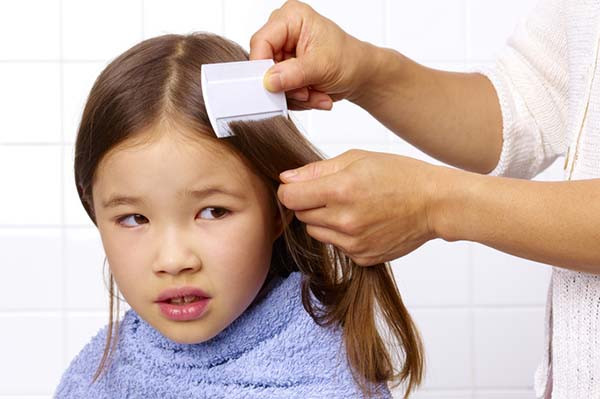What do head lice look like and what should you do if you find them?
- Reviewed by Howard E. LeWine, MD, Chief Medical Editor, Harvard Health Publishing; Editorial Advisory Board Member, Harvard Health Publishing

Head lice are not dangerous, but they can be uncomfortable and distressing. It's helpful to know what these unwelcome visitors look like, and what to do if you find them in your hair.
What are head lice?
Head lice are insects that live in human hair, close to the scalp, and sometimes in the eyebrows and eyelashes too. They are tiny, no bigger than a sesame seed.
Lice are parasites that bite the scalp every few hours to feed on blood. The bites from lice can make your scalp itchy. Itching is the most common symptom of a head lice infestation. You also may feel like something is moving in your hair.
Head lice are found all over the world. Contrary to popular belief, they have nothing to do with personal hygiene or cleanliness, and they do not carry diseases.
Lice can spread from person to person from head-to-head contact.
What do lice look like?
There are three life stages of head lice: nits (eggs), nymphs, and adults.
Nits are the eggs laid by an adult female. Eggs attach firmly to the hair shaft, very close to the scalp. The eggs are shaped like tiny ovals and are usually yellow or white. Nits usually take about a week to hatch.
Nymphs are young lice. They resemble an adult but are smaller. Nymphs develop into adults about a week and a half after hatching from nits.
Adult lice are fully grown. They hold tightly to hair with hooklike claws on each of their six legs. They are tan, gray, or white. They live about a month on a person's head and will die within a day or two if they fall off. Adult females can lay about six eggs a day.
Is it lice or dandruff?
It's easy to confuse nits and lice with dandruff. You can tell the difference if you try to brush or shake them off. Dandruff doesn't stick to hair, but nits do.
One way to check is to use a fine-tooth comb or a lice comb on wet hair. Part the hair in small sections to look for nits or lice. A magnifying glass and bright light can help.
How do lice spread from person to person?
Head lice can't fly or hop. They move by crawling and spread through head-to head contact with a person who has them. This is especially common among young children at play or through sports activities.
They can also spread if loose strands of hair with lice or nits on them come into contact with someone else's hair by:
- sharing clothing such as hats, scarves, and coats
- sharing personal items such as combs, brushes, and hair ribbons
- lying on a bed, pillow, sofa, or carpet that had recently been in contact with someone who had head lice.
You can't get head lice from dogs, cats, or other pets, and you can't give them to pets, either.
How to treat lice at home
You can treat head lice at home with a lice comb and a medicated shampoo or lotion, available over the counter. The active ingredient in these products is either pyrethrins, approved for ages 2 years and older, or permethrin lotion, approved for ages 2 months and older.
After applying and rinsing the head lice shampoo according to directions on the product, divide hair into small sections and comb through each section using the comb and your fingers to remove lice and eggs. Experts suggest combing the hair with a lice comb every few days for at least two weeks to look for any remaining lice or nits. After each treatment, do not wash hair with regular shampoo for two days.
Lice shampoos kill live lice but not eggs, so you'll likely need more than one treatment to kill lice that hatch after the first treatment. Some lice shampoos recommend two treatments regardless of whether you see lice or eggs, while others recommend a second treatment only if you see crawling lice after a week. Because head lice are so contagious, experts suggest treating the whole family, even if no lice are seen.
Lice don't survive for more than a day or two if they fall off a person, so deep home cleaning usually isn't necessary. Wash bedding and towels in hot water, or seal them in a plastic bag for two weeks if they can't be washed. Vacuum floors, and soak combs and brushes in very hot water for at least 10 minutes.
When to see a doctor
See a doctor if home treatment doesn't work. You may need a stronger prescription medicated lotion. If the lice still don't go away, you may need to take a medication by mouth.
Scratching your head a lot in response to the itching can lead to a rash or infection. See a doctor if you have signs of an infection, such as skin on your scalp that is tender, crusting, or oozing.
About the Author

Lisa Catanese, ELS, Health Writer
About the Reviewer

Howard E. LeWine, MD, Chief Medical Editor, Harvard Health Publishing; Editorial Advisory Board Member, Harvard Health Publishing
Disclaimer:
As a service to our readers, Harvard Health Publishing provides access to our library of archived content. Please note the date of last review or update on all articles.
No content on this site, regardless of date, should ever be used as a substitute for direct medical advice from your doctor or other qualified clinician.















